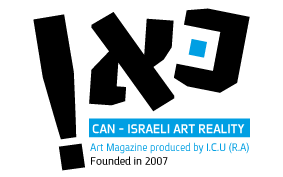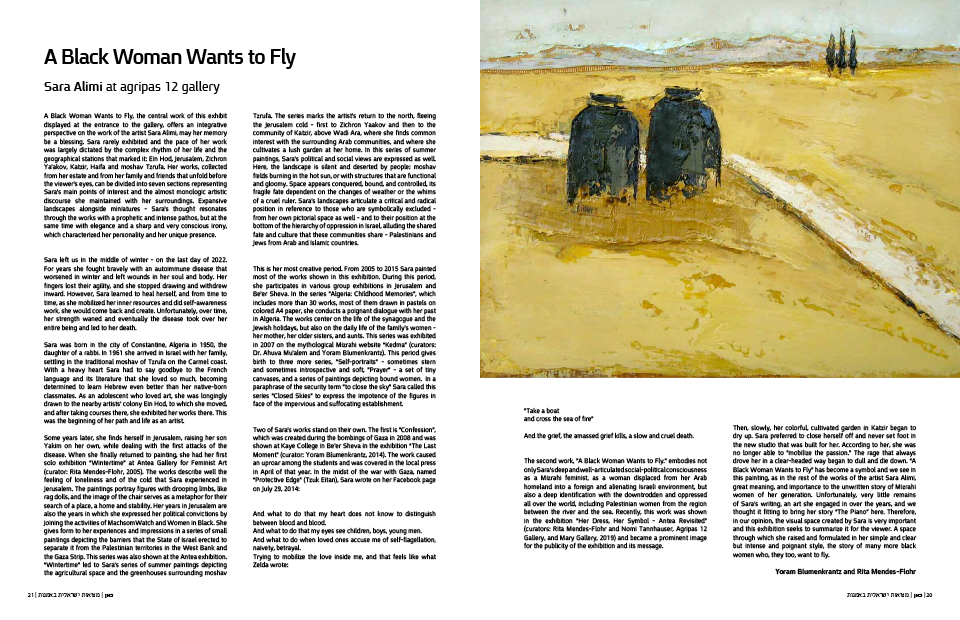
| Home Page | Editor Notices | Museums | Galleries | Publication | Donation | Contact Us |


 | |||||||||||||||
| |||||||||||||||


| |||||||||||||||
| Sara Alimi at agripas 12 gallery |
A Black Woman Wants to Fly, the central work of this exhibit displayed at the entrance to the gallery, offers an integrative perspective on the work of the artist Sara Alimi, may her memory be a blessing. Sara rarely exhibited and the pace of her work was largely dictated by the complex rhythm of her life and the geographical stations that marked it: Ein Hod, Jerusalem, Zichron Ya'akov, Katzir, Haifa and moshav Tzrufa. Her works, collected from her estate and from her family and friends that unfold before the viewer's eyes, can be divided into seven sections representing Sara’s main points of interest and the almost monologic artistic discourse she maintained with her surroundings. Expansive landscapes alongside miniatures - Sara's thought resonates through the works with a prophetic and intense pathos, but at the same time with elegance and a sharp and very conscious irony, which characterized her personality and her unique presence. Sara left us in the middle of winter - on the last day of 2022. For years she fought bravely with an autoimmune disease that worsened in winter and left wounds in her soul and body. Her fingers lost their agility, and she stopped drawing and withdrew inward. However, Sara learned to heal herself, and from time to time, as she mobilized her inner resources and did self-awareness work, she would come back and create. Unfortunately, over time, her strength waned and eventually the disease took over her entire being and led to her death. Sara was born in the city of Constantine, Algeria in 1950, the daughter of a rabbi. In 1961 she arrived in Israel with her family, settling in the traditional moshav of Tzrufa on the Carmel coast. With a heavy heart Sara had to say goodbye to the French language and its literature that she loved so much, becoming determined to learn Hebrew even better than her native-born classmates. As an adolescent who loved art, she was longingly drawn to the nearby artists' colony Ein Hod, to which she moved, and after taking courses there, she exhibited her works there. This was the beginning of her path and life as an artist. Some years later, she finds herself in Jerusalem, raising her son Yakim on her own, while dealing with the first attacks of the disease. When she finally returned to painting, she had her first solo exhibition “Wintertime” at Antea Gallery for Feminist Art (curator: Rita Mendes-Flohr, 2005). The works describe well the feeling of loneliness and of the cold that Sara experienced in Jerusalem. The paintings portray figures with drooping limbs, like rag dolls, and the image of the chair serves as a metaphor for their search of a place, a home and stability. Her years in Jerusalem are also the years in which she expressed her political convictions by joining the activities of MachsomWatch and Women in Black. She gives form to her experiences and impressions in a series of small paintings depicting the barriers that the State of Israel erected to separate it from the Palestinian territories in the West Bank and the Gaza Strip. This series was also shown at the Antea exhibition. “Wintertime” led to Sara's series of summer paintings depicting the agricultural space and the greenhouses surrounding moshav Tzrufa. The series marks the artist's return to the north, fleeing the Jerusalem cold - first to Zichron Yaakov and then to the community of Katzir, above Wadi Ara, where she finds common interest with the surrounding Arab communities, and where she cultivates a lush garden at her home. In this series of summer paintings, Sara's political and social views are expressed as well. Here, the landscape is silent and deserted by people; moshav fields burning in the hot sun, or with structures that are functional and gloomy. Space appears conquered, bound, and controlled, its fragile fate dependent on the changes of weather or the whims of a cruel ruler. Sara's landscapes articulate a critical and radical position in reference to those who are symbolically excluded - from her own pictorial space as well - and to their position at the bottom of the hierarchy of oppression in Israel, alluding the shared fate and culture that these communities share - Palestinians and Jews from Arab and Islamic countries. This is her most creative period. From 2005 to 2015 Sara painted most of the works shown in this exhibition. During this period, she participates in various group exhibitions in Jerusalem and Be'er Sheva. In the series "Algeria: Childhood Memories", which includes more than 30 works, most of them drawn in pastels on colored A4 paper, she conducts a poignant dialogue with her past in Algeria. The works center on the life of the synagogue and the Jewish holidays, but also on the daily life of the family’s women - her mother, her older sisters, and aunts. This series was exhibited in 2007 on the mythological Mizrahi website “Kedma” (curators: Dr. Ahuva Mu’alem and Yoram Blumenkrantz). This period gives birth to three more series, "Self-portraits" - sometimes stern and sometimes introspective and soft, "Prayer" - a set of tiny canvases, and a series of paintings depicting bound women. In a paraphrase of the security term "to close the sky" Sara called this series "Closed Skies" to express the impotence of the figures in face of the impervious and suffocating establishment. Two of Sara's works stand on their own. The first is "Confession", which was created during the bombings of Gaza in 2008 and was shown at Kaye College in Be'er Sheva in the exhibition “The Last Moment” (curator: Yoram Blumenkrantz, 2014). The work caused an uproar among the students and was covered in the local press in April of that year. In the midst of the war with Gaza, named “Protective Edge” (Tzuk Eitan), Sara wrote on her Facebook page on July 29, 2014: And what to do that my heart does not know to distinguish between blood and blood. And what to do that my eyes see children, boys, young men. And what to do when loved ones accuse me of self-flagellation, naivety, betrayal. Trying to mobilize the love inside me, and that feels like what Zelda wrote: "Take a boat and cross the sea of fire" And the grief, the amassed grief kills, a slow and cruel death. The second work, "A Black Woman Wants to Fly." embodies not only Sara's deep and well-articulated social-political consciousness as a Mizrahi feminist, as a woman displaced from her Arab homeland into a foreign and alienating Israeli environment, but also a deep identification with the downtrodden and oppressed all over the world, including Palestinian women from the region between the river and the sea. Recently, this work was shown in the exhibition "Her Dress, Her Symbol – Antea Revisited" (curators: Rita Mendes-Flohr and Nomi Tannhauser, Agripas 12 Gallery, and Mary Gallery, 2019) and became a prominent image for the publicity of the exhibition and its message. Then, slowly, her colorful, cultivated garden in Katzir began to dry up. Sara preferred to close herself off and never set foot in the new studio that was built for her. According to her, she was no longer able to "mobilize the passion." The rage that always drove her in a clear-headed way began to dull and die down. “A Black Woman Wants to Fly” has become a symbol and we see in this painting, as in the rest of the works of the artist Sara Alimi, great meaning, and importance to the unwritten story of Mizrahi women of her generation. Unfortunately, very little remains of Sara's writing, an art she engaged in over the years, and we thought it fitting to bring her story “The Piano” here. Therefore, in our opinion, the visual space created by Sara is very important and this exhibition seeks to summarize it for the viewer. A space through which she raised and formulated in her simple and clear but intense and poignant style, the story of many more black women who, they too, want to fly. Yoram Blumenkrantz and Rita Mendes-Flohr Read more  |
| all rights reserved - CAN ISRAELI ART REALITY |
| סייבורג מחשבים - בניית אתרים |